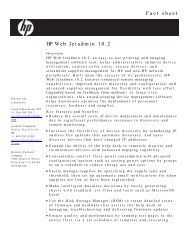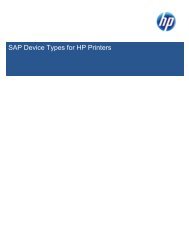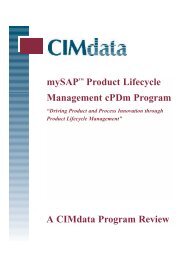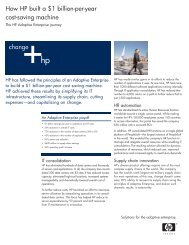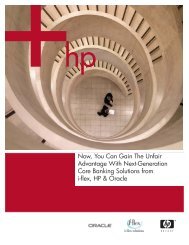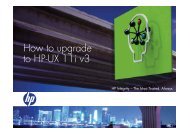Debunking remanufactured toner cartridge myths - HP
Debunking remanufactured toner cartridge myths - HP
Debunking remanufactured toner cartridge myths - HP
You also want an ePaper? Increase the reach of your titles
YUMPU automatically turns print PDFs into web optimized ePapers that Google loves.
<strong>Debunking</strong><br />
<strong>remanufactured</strong><br />
<strong>toner</strong> <strong>cartridge</strong> <strong>myths</strong><br />
Jim Hardin,<br />
Hewlett Packard<br />
March 5 th , 2008<br />
© 2005 Hewlett-Packard Development Company, L.P.<br />
The information contained herein is subject to change without notice
Top <strong>myths</strong> about <strong>remanufactured</strong><br />
<strong>toner</strong> <strong>cartridge</strong>s<br />
1. Remans always save you money<br />
2. Reman page yields always equal<br />
those of <strong>HP</strong> <strong>cartridge</strong>s<br />
3. Reman print quality consistently<br />
equals that of <strong>HP</strong> <strong>cartridge</strong>s<br />
4. Remans meet <strong>HP</strong> technical<br />
specifications<br />
5. Remans are better for the<br />
environment<br />
6. Remans are just as reliable as<br />
genuine <strong>HP</strong> <strong>cartridge</strong>s<br />
7. Remans won’t hurt your printer<br />
3/17/2008 2
Myth 1:<br />
Remans always save you money<br />
• Remans reuse critical <strong>cartridge</strong><br />
components that may be damaged or<br />
near the end of their usable life<br />
- Cause more print quality issues<br />
- Generate higher failure rates<br />
- Increase “hidden” costs<br />
• QualityLogic* tests found every 100<br />
remans generate:<br />
- 5 extra support calls<br />
- 23,000 extra reprints<br />
- 3.75 additional <strong>cartridge</strong> repurchases**<br />
• Greater <strong>HP</strong> reliability means lower costs<br />
over the life of the <strong>cartridge</strong><br />
* In a 2003 independent testing study performed by QualityLogic, Inc. (Reliability Comparison Study) and commissioned by <strong>HP</strong>, performance of original <strong>HP</strong> monochrome <strong>toner</strong> and black and color inkjet print<br />
<strong>cartridge</strong>s was compared to leading remanufacturer brands on a broad spectrum of reliability issues. Cartridge models tested were the ones with the biggest aftermarket for which new printers could be acquired<br />
for testing. Samples of 100 <strong>HP</strong> LaserJet print <strong>cartridge</strong>s, 151 black <strong>HP</strong> inkjet print <strong>cartridge</strong>s, and 110 color <strong>HP</strong> inkjet print <strong>cartridge</strong>s were compared to 390, 363, and 429 <strong>remanufactured</strong> <strong>cartridge</strong>s,<br />
respectively—from 8 leading remanufacturer <strong>toner</strong> <strong>cartridge</strong> brands and 7 leading remanufacturer ink <strong>cartridge</strong> brands. QualityLogic, Inc. is one of the world's largest, most qualified independent quality<br />
assurance organizations, providing testing services to every major printer manufacturer.<br />
** <strong>HP</strong> customer research in 2004 shows that only 3 out of 5 (60% of) defective <strong>cartridge</strong>s identified are returned to the vendor for refund or replacement.<br />
3/17/2008 3
Myth 2: Reman page yields always<br />
equal those of <strong>HP</strong> <strong>cartridge</strong>s<br />
• Many remanufacturers achieve stated page yields only when<br />
the density setting is turned down<br />
- A lower density setting is like printing in draft mode<br />
- Making these adjustments can artificially increase yields<br />
for any <strong>cartridge</strong> brand<br />
- <strong>HP</strong> bases its page yield estimates on certified<br />
ISO standards using default <strong>toner</strong> density dial settings<br />
• Remans often overfill their <strong>cartridge</strong>s to achieve stated yields<br />
- Overfilled <strong>cartridge</strong>s can leak into the printer and<br />
damage critical components<br />
3/17/2008 4
Myth 3: Reman print quality<br />
consistently equals that of <strong>HP</strong> <strong>cartridge</strong>s<br />
• Remanufacturing is a manual process subject to damage,<br />
leading to performance and print quality problems<br />
• Remans use low-quality <strong>toner</strong> with irregularly shaped<br />
particles and impurities that can cause print quality<br />
defects<br />
• QualityLogic found that, on average, <strong>remanufactured</strong><br />
<strong>toner</strong> <strong>cartridge</strong>s tested were eight times more likely than<br />
<strong>HP</strong> print <strong>cartridge</strong>s tested to print a high number of pages<br />
with unacceptable quality *<br />
• Lyra Research found that 96% of <strong>HP</strong> Color LaserJet users<br />
who tried non-<strong>HP</strong> <strong>cartridge</strong>s experienced problems such<br />
as spotting, blurring, smearing and streaking **<br />
<strong>HP</strong>’s spherical,<br />
uniform <strong>toner</strong> particles<br />
Jagged reman <strong>toner</strong><br />
particles<br />
* In a 2003 independent testing study performed by QualityLogic, Inc. (Reliability Comparison Study) and commissioned by <strong>HP</strong>, performance of original <strong>HP</strong> monochrome <strong>toner</strong> and black and color inkjet print<br />
<strong>cartridge</strong>s was compared to leading remanufacturer brands on a broad spectrum of reliability issues. Cartridge models tested were the ones with the biggest aftermarket for which new printers could be<br />
acquired for testing. Samples of 100 <strong>HP</strong> LaserJet print <strong>cartridge</strong>s, 151 black <strong>HP</strong> inkjet print <strong>cartridge</strong>s, and 110 color <strong>HP</strong> inkjet print <strong>cartridge</strong>s were compared to 390, 363, and 429 <strong>remanufactured</strong><br />
<strong>cartridge</strong>s, respectively—from 8 leading remanufacturer <strong>toner</strong> <strong>cartridge</strong> brands and 7 leading remanufacturer ink <strong>cartridge</strong> brands. QualityLogic, Inc. is one of the world's largest, most qualified independent<br />
quality assurance organizations, providing testing services to every major printer manufacturer.<br />
** Lyra Research, Inc. 09/03.<br />
3/17/2008 5
Myth 4:<br />
Remans meet <strong>HP</strong> technical specifications<br />
• Remanufacturers try to mimic <strong>HP</strong> technology, but since<br />
<strong>HP</strong> specs are proprietary and unpublished, it’s<br />
impossible<br />
- <strong>HP</strong> invests more than $1 billion a year in R&D for its<br />
printing systems<br />
- <strong>HP</strong> has more than 9,000 patents worldwide on its printing<br />
and imaging technology<br />
• Remans refurbish older model <strong>cartridge</strong>s and can lag<br />
several months to years behind <strong>HP</strong><br />
• <strong>HP</strong> LaserJet print <strong>cartridge</strong>s feature advanced technology<br />
designed to work precisely with <strong>HP</strong> printers, <strong>toner</strong> and<br />
paper<br />
3/17/2008 6
Myth 5:<br />
Remans are better for the environment<br />
• Remanufacturers are unable to refurbish many<br />
of the used <strong>cartridge</strong>s they acquire—and<br />
many likely end up in landfills<br />
- Through its Planet Partners program, <strong>HP</strong> makes<br />
it free and easy to return empty <strong>HP</strong> inkjet and<br />
LaserJet <strong>cartridge</strong>s for recycling<br />
• Remanufacturing creates waste that must be<br />
discarded, including worn parts and residual<br />
<strong>toner</strong><br />
• An <strong>HP</strong> LaserJet print <strong>cartridge</strong> recycled<br />
through <strong>HP</strong>’s Planet Partners program has no<br />
greater environmental impact than a<br />
<strong>remanufactured</strong> <strong>cartridge</strong>*<br />
* LaserJet Cartridge Environmental Comparison, First Environment, Inc.,10/04<br />
3/17/2008 7
Myth 6: Remans are just as reliable<br />
as genuine <strong>HP</strong> <strong>cartridge</strong>s<br />
• In its annual “Reader Satisfaction<br />
Survey,” PC Magazine awarded <strong>HP</strong><br />
the top grade of A+ for the 12 th year<br />
in a row for superior reliability,<br />
service, support and satisfaction<br />
• QualityLogic found that genuine<br />
<strong>HP</strong> LaserJet <strong>cartridge</strong>s tested were,<br />
on average, more than nine times<br />
more reliable than <strong>remanufactured</strong><br />
<strong>cartridge</strong>s tested<br />
3/17/2008 8
Myth 7:<br />
Remans won’t hurt your printer<br />
• PS Technologies found that laser<br />
printers using remans required eight<br />
times more repairs than printers using<br />
genuine <strong>HP</strong> LaserJet print <strong>cartridge</strong>s*<br />
• At a cost of over $90 per repair, the<br />
total cost of using remans may exceed<br />
using genuine <strong>HP</strong> <strong>cartridge</strong>s**<br />
• Remans leak more, causing dusting<br />
inside the printer, banding, background<br />
gray, <strong>toner</strong> blobs, mystery dots and<br />
other print quality defects<br />
• A leaking <strong>cartridge</strong> can shorten the life<br />
of the printer fuser<br />
* PS Technologies, 09/03<br />
** Repair cost source: computerrepair.com. On 4/18/05, an average printer repair in the US cost $93.21.<br />
Banding caused by impurities in reman <strong>toner</strong><br />
3/17/2008 9
No <strong>myths</strong>, just facts<br />
• A failed reman <strong>cartridge</strong><br />
wastes supplies and drains<br />
time and productivity—hidden<br />
costs that add up<br />
• Why take a risk on<br />
compromised quality and<br />
printer performance? It pays<br />
to go with <strong>HP</strong><br />
<strong>HP</strong> Reliability<br />
Minimizes hidden costs.<br />
Maximizes value.<br />
3/17/2008 10
Current Fleet By Printer Models<br />
Monochrome LaserJet %<br />
LJ 4, 5 0.9%<br />
LJ 5Si, 8000, 8050 3.2%<br />
LJ 2100, 2200 2.2%<br />
LJ 4000, 4050 3.6%<br />
LJ 5000, 5100 3.9%<br />
LJ 8100, 8150 4.6%<br />
LJ 4100 4.6%<br />
LJ 9000, 9050 5.3%<br />
LJ 4200 1.1%<br />
LJ 4250, 4350 9.3%<br />
LJ 2400, 2420, 2430 0.7%<br />
Total -- All Monochrome 41.3%<br />
3/17/2008 11
Current Fleet By Printer Models<br />
Color LaserJet Supplies %<br />
CLJ 3500, 3550 1.0%<br />
CLJ 3800, CP3505 1.0%<br />
CLJ 4500, 4550 1.2%<br />
CLJ 4600, 4650 7.8%<br />
CLJ 4700 4.6%<br />
CLJ 5500, 5550 40.1%<br />
CLJ 8500, 8550 2.5%<br />
Total -- All Color 58.7%<br />
3/17/2008 12
Supplies Purchases by Age of Printers<br />
LaserJet Supplies Purchases by Age of Printer<br />
Older than 8 Years<br />
18%<br />
Between 4 and 8 Years<br />
Old<br />
16%<br />
3 Years Old or Newer<br />
66%<br />
3/17/2008 13
Thank You!<br />
877-278-3309<br />
James.hardin@hp.com




